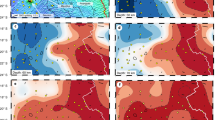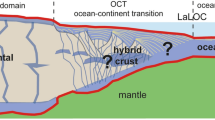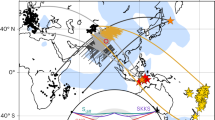Abstract
A long-standing question about the dynamics of mid-ocean spreading centres is whether mantle upwelling is passive or active. During passive upwelling, the motion of the overlying plate would be expected to drive mantle flow1,2. In contrast, during active upwelling, decompression melting of the mantle beneath the spreading axis would result in a low-density melt that creates local buoyancy, forcing mantle convection and driving plate motion3,4. Seismic images of older parts of the Pacific Plate reveal dipping reflectors in the lower crust that could be shear zones created by active mantle flow5,6,7, but there is little seismological evidence to indicate that mantle flow drags the plate. Here we use active-source seismic data to image the Pacific Plate that was created at a palaeo-spreading centre in the northwest Pacific Ocean. We identify very high P-wave velocities of 8.5–8.6 km s−1 and strong seismic anisotropy of 8.5–9.8% in the uppermost mantle, immediately below the lower-crustal dipping reflectors. We suggest that such strong seismic anisotropy, caused by the alignment of olivine crystals in response to mantle flow, could have been generated if mantle flow was much faster than plate motion. We conclude that both the lower-crustal dipping reflectors and the anisotropy were formed by a drag force at the Moho caused by rapid mantle flow, providing direct evidence for active mantle flow at a spreading centre.
This is a preview of subscription content, access via your institution
Access options
Subscribe to this journal
Receive 12 print issues and online access
$259.00 per year
only $21.58 per issue
Buy this article
- Purchase on Springer Link
- Instant access to full article PDF
Prices may be subject to local taxes which are calculated during checkout




Similar content being viewed by others
References
Forsyth, D. W. in Mantle Flow and Melt Generation at Mid-Ocean Ridges (eds Morgan, J. P., Blackman, D. K. & Sinton, J. M.) 1–65 (Geophysical Monogr. 71, AGU, 1992).
Blackman, D. K. & Forsyth, D. W. in Mantle Flow and Melt Generation at Mid-Ocean Ridges (eds Morgan, J. P., Blackman, D. K. & Sinton, J. M.) 311–326 (Geophysical Monogr. 71, AGU, 1992).
Scott, D. R. in Mantle Flow and Melt Generation at Mid-Ocean Ridges (eds Morgan, J. P., Blackman, D. K. & Sinton, J. M.) 327–352 (Geophysical Monogr. 71, AGU, 1992).
Toomey, D., Jousselin, D., Dunn, R. A., Wilcock, W. S. D. & Detrick, R. S. Skew of mantle upwelling beneath the East Pacific Rise governs segmentation. Nature 446, 409–414 (2007).
White, R. S. et al. New seismic images of oceanic crustal structure. Geology 18, 462–465 (1990).
Morgan, J. P. & Chen, Y. J. The genesis of oceanic crust: Magma injection, hydrothermal circulation, and crustal flow. J. Geophys. Res. 98, 6283–6297 (1993).
Ranero, C. R., Reston, T. J., Belykh, I. & Gnibidenko, H. Reflective oceanic crust formed at a fast-spreading centre in the Pacific. Geology 25, 499–502 (1997).
Nicolas, A. & Boudier, F. Mapping oceanic ridge segments in Oman ophiolite. J. Geophys. Res. 100, 6179–6197 (1995).
Hess, H. H. Seismic anisotropy of the uppermost mantle under oceans. Nature 203, 629–631 (1964).
Shimamura, H., Asada, T., Suyehiro, K., Yamada, T. & Inatani, H. Longshot experiments to study velocity anisotropy in the oceanic lithosphere of the northwestern Pacific. Phys. Earth Planet. Inter. 31, 348–362 (1983).
Nakanishi, M., Tamaki, K. & Kobayashi, K. Mesozoic magnetic anomaly lineations and seafloor spreading history of the northwestern Pacific. J. Geophys. Res. 94, 15437–15462 (1989).
Fujie, G. et al. Systematic changes in the incoming plate structure at the Kuril Trench. Geophys. Res. Lett. 40, 88–93 (2013).
Kobayashi, K., Nakanishi, M., Tamaki, K. & Ogawa, Y. Outer slope faulting associated with the western Kuril and Japan trenches. Geophys. J. Int. 134, 356–372 (1998).
White, R. S., McKenzie, D. & O’Nions, R. Oceanic crustal thickness from seismic measurements and rare earth element inversions. J. Geophys. Res. 97, 19683–19715 (1992).
Oikawa, M., Kaneda, K. & Nishizawa, A. Seismic structures of the 154–160 Ma oceanic crust and uppermost mantle in the Northwest Pacific Basin. Earth Planet. Space 62, e13–e16 (2010).
Jousselin, D. & Maimprice, D. Melt topology and seismic anisotropy in mantle peridotites of the Oman ophiolite. Earth Planet. Sci. Lett. 164, 553–568 (1998).
Reston, T. J., Ranero, C. R. & Belykh, I. The structure of Cretaceous oceanic crust of the NW Pacific: Constraints on processes at fast spreading centres. J. Geophys. Res. 104, 629–644 (1999).
Ten Brink, U. S. & Brocher, T. M. Multichannel seismic evidence for variations in crustal thickness across the Molokai fracture zone in the mid-Pacific. J. Geophys. Res. 93, 1119–1130 (1988).
Eittreim, S. L. et al. Oceanic crustal thickness and seismic character along a central Pacific transect. J. Geophys. Res. 99, 3139–3145 (1994).
Morgan, J. P. & Chen, Y. J. The genesis of oceanic crust: Magma injection, hydrothermal circulation and crustal flow. J. Geophys. Res. 98, 6283–6297 (1993).
Nicolas, A. Comment on ‘The genesis of oceanic crust: Magma injection, hydrothermal circulation, and crustal flow’ by Jason Phipps Morgan and Y. John Chen. J. Geophys. Res. 99, 12029–12030 (1994).
Karson, J. A., Collins, J. A. & Casey, J. F. Geologic and seismic velocity structure of the crust/mantle transition in the Bay of Islands ophiolite complex. J. Geophys. Res. 89, 6126–6138 (1984).
Zhang, S. & Karato, S. Lattice preferred orientation of olivine aggregates deformed in simple shear. Nature 375, 774–777 (1995).
Nicolas, A. & Christensen, N. I. in Formation of Anisotropy in Upper Mantle Peridotites—A Review in Composition, Structure and Dynamics of the Lithosphere–Asthenosphere System (eds Fuchs K. & Froidevaux C.) 111–123 (Geodyn. Ser. Vol. 16, AGU, 1987)
Tchalenko, J. S. Similarities between shear zones of different magnitudes. Geol. Soc. Amer. Bull. 81, 1625–1640 (1970).
Pearce, J. A. in Ophiolite Concept and the Evolution of Geological Thought (eds Dilek, Y. & Newcomb, S.) Supra-subduction zone ophiolites: the search for modern analogues. 269–294 (Special Paper, Geological Society of America, 2003).
Nicolas, A. & Boudier, F. in Ophiolite Concept and the Evolution of Geological Thought (eds Dilek, & Newcomb, S.) Where ophiolites come from and what they tell us. 137–152 (Special Paper, Geological Society of America, 2003).
Sato, T. & Kennett, B. L. N. Two-dimensional refraction inversion by progressive model development. Geophys. J. Int. 140, 543–558 (2000).
Michibayashi, K., Gerbert-Gaillard, L. & Nicolas, A. Shear sense inversion in the Hilti mantle section (Oman ophiolite) and active mantle uprise. Mar. Geophys. Res. 21, 259–268 (2000).
Karson, J. A. et al. Structure of uppermost fast-spread oceanic crust exposed at the Hess Deep Rift: Implications for subaxial processes at the East Pacific Rise. Geochem. Geophys. Geosys. 3, 1002 (2002).
Acknowledgements
This study was partly financially supported by the Institute for Research on Earth Evolution, Japan Agency for Marine-Earth Science and Technology.
Author information
Authors and Affiliations
Contributions
S.K. designed the seismic surveys, interpreted the seismic data and wrote the paper with contributions from all of the co-authors. G.F. participated in data acquisition and processing. M.Y. participated in data processing. T.T., T.S. and N.T. participated in data acquisition.
Corresponding author
Ethics declarations
Competing interests
The authors declare no competing financial interests.
Supplementary information
Supplementary Information
Supplementary Information (PDF 43906 kb)
Rights and permissions
About this article
Cite this article
Kodaira, S., Fujie, G., Yamashita, M. et al. Seismological evidence of mantle flow driving plate motions at a palaeo-spreading centre. Nature Geosci 7, 371–375 (2014). https://doi.org/10.1038/ngeo2121
Received:
Accepted:
Published:
Issue Date:
DOI: https://doi.org/10.1038/ngeo2121
This article is cited by
-
The nature of the Pacific plate as subduction inputs to the northeastern Japan arc and its implication for subduction zone processes
Progress in Earth and Planetary Science (2023)
-
Hydrothermal ferromanganese oxides around a petit-spot volcano on old and cold oceanic crust
Communications Earth & Environment (2023)
-
Middle-lower continental crust exhumed at the distal edges of volcanic passive margins
Communications Earth & Environment (2022)
-
Pervasive detachment faults within the slow spreading oceanic crust at the poorly coupled Antilles subduction zone
Communications Earth & Environment (2021)
-
Lateral variation of the uppermost oceanic plate in the outer-rise region of the Northwest Pacific Ocean inferred from Po-to-s converted waves
Earth, Planets and Space (2018)



